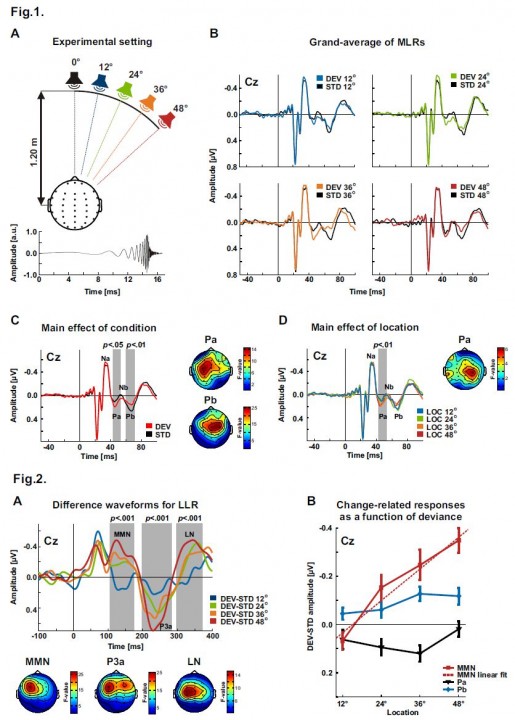The paper entitled Functional dissociation between regularity encoding and deviance detection along the auditory hierarchy, by Maryam Aghamolaei, Katarzyna Zarnowiec, Sabine Grimm, & Carles Escera, has been accepted for publication in European Journal of Neuroscience.
Maryam Aghamolaei, Phd student from Tehran University (Iran), had a six-month visit in our lab, during which she managed to complet an experiment aimed at testing the relationships between the systems for deviance detection and regularity encoding at early- and long-latencies. For that, she recorded deviance-related responses to four levels of location deviants (i.e., 12, 24, 36 and 48 degrees from a central location) in the middle-latency response as well as the mismatch negativity (MMN). Results revealed clear deviance detection at the two latency levels, indicating regularity encoding at these two stages of the auditory hierarchy. However, only the MMN was able to track deviance, as it increased in amplitude as a function of the location difference between the standard and the deviant. These results point to a functional dissociating between early and late levels in the auditory system for regularity encoding.
The full abstract reads as follows:
Auditory deviance detection based on regularity encoding appears as one of the basic functional properties of the auditory system. It has traditionally been assessed with the mismatch negativity long-latency component of the auditory evoked potential. Recent studies have found earlier correlates of deviance detection based on regularity encoding. They occur in humans in the first 50 ms after sound onset, at the level of the middle latency response of the auditory evoked potential and parallel findings of stimulus specific adaptation observed in animal studies. However, the functional relationship between these different levels of regularity encoding and deviance detection along the auditory hierarchy has not yet been clarified. Here we addressed this issue by examining deviant-related responses at different levels of the auditory hierarchy to stimulus changes varying in their degree of deviation regarding the spatial location of a repeated standard stimulus. Auditory stimuli were presented randomly from five loudspeakers at azimuthal angles of 0°, 12°, 24°, 36° and 48° during oddball and reversed-oddball conditions. Middle latency responses and mismatch negativity were measured. Our results revealed that middle latency responses were sensitive to deviance but not the degree of deviation, whereas mismatch negativity amplitude increased as a function of deviance magnitude. These findings indicate that acoustic regularity can be encoded at the level of middle latency response but that it takes a higher step in the auditory hierarchy for deviance magnitude to be encoded, thus providing a functional dissociation between regularity encoding and deviance detection along the auditory hierarchy.


